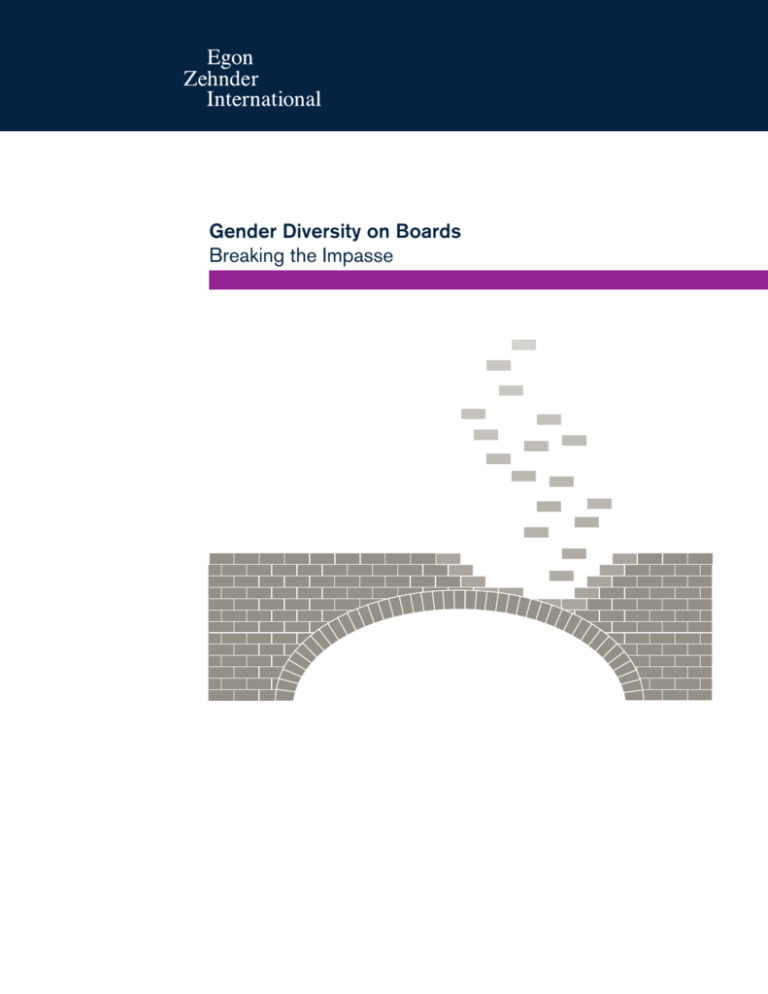
Gender Diversity on Boards
Breaking the Impasse
Gender Diversity on Boards: Breaking the Impasse
Amid all of today’s talk about the desirability of bringing more women onto
corporate boards, two indisputable facts stand out: One, the business case
for board diversity of all kinds, including gender diversity, has been well
established and widely accepted. Two, over the past decade, progress
has been negligible. Here is what boards, top management, female
candidates, and executive search firms can do about it.
Despite the widespread acceptance of the business case for diversity, the percentage of women
on Fortune 500 company boards has remained stuck for the past seven years at around 15
percent. In both 2010 and 2011, about one-tenth of companies had no female directors at
all. The future could be even darker, as recent research by our firm suggests: Over the past
five years, the number of women reaching senior executive roles has decreased by 12 percent,
shrinking the talent pool from which most female directors are likely to be drawn. Despite
some recent high-profile appointments, only 3 percent of Fortune 500 CEOs are women, and
– as any board search professional can attest – boards still almost reflexively seek sitting or
retired CEOs to fill board seats.
12%
Fortune 500
Board Members
Fortune 500
CEOs
Over the past 5 years, the number
of women reaching senior executive
roles has decreased by 12%
Source: EEOC Labor Statistics 2000 & 2010
Female
Board Members
16%
4%
2.4%
2012 Female Executives
2007 Female Executives
Figure 1
Fortune 500 Female Representation
Source: Fortune 500 Board statistics from Catalyst Quick Takes 2012
Fortune 500 CEO statistics from CNN Money
2
Egon Zehnder International
Gender Diversity on Boards: Breaking the Impasse
Government
8%
Academic
C-2
Great Expectations: The P&L Perspective
Other
Non-Profit
C-Level
3% 4%
Chairman
& CEO
32%
15%
4%
34%
C-1
Functional
30%
P&L
70%
Figure 2
Profiles of Current Female
Directors of Fortune 100
It’s no surprise that boards see CEOs (and COOs) as most qualified
to oversee multi-billion dollar corporations and to fulfill the chief
responsibilities of directors – to hire and fire the chief executive,
set compensation for top management, validate strategy in terms of
shareholder value, and ensure corporate integrity and sound risk
management. For many boards in search of a new director the bottom
line is literally the bottom line: they want someone who has been
responsible for a significant P&L, and the title “CEO” is used as a proxy,
sometimes incorrectly. When boards fully realize the difficulty of finding
a Fortune 500 female CEO to join them, they often try to come as close
as they can to the CEO profile.
Any approach to increasing gender diversity on boards will have to
address this overwhelming preference on two fronts simultaneously:
by broadening the perspective on what constitutes valuable experience
and by making sure that women get the experiences that help qualify
them for board service. All of the interested parties – boards, top
management, aspiring female directors, and board search professionals –
have a distinctive role to play. By taking some highly specific actions we
can not only increase board diversity but, more importantly, realize the
promise of the business case.
Source: 2011 Egon Zehnder analysis
The real purpose of increasing gender diversity is not simply to increase the
number of women on the board, but to find exceptional directors who can help
take the organization to the highest level of performance.
What Boards Can Do: Adopt New Perspectives and Processes
In some countries the issue of gender diversity on boards has simply been addressed through
government-mandated quotas, but quotas remain controversial in many other regions. For
most Fortune 500 boards there is no simple solution that will change deeply ingrained
practices overnight. For most, achieving gender diversity will require a concerted effort to
adopt some new perspectives and some new processes, including:
3
Egon Zehnder International
Gender Diversity on Boards: Breaking the Impasse
Thinking holistically about the board’s needs. When the Nominating Committee is
developing a profile of the desired candidate for a board opening they should avoid the
tendency to establish qualifications that could only be fulfilled by a CEO or COO and think
more flexibly about the competencies the board needs. Because boards often view the head
of a function as presiding over a narrow silo that does not qualify that individual to take the
enterprise-wide strategic view, they overlook this rich source of potential directors. However
the issue should not be whether they have had staff rather than line experience, but whether
they have, for example, demonstrable and exceptional competence in an area where the board
is lacking.
Requiring that the shortlist of candidates for a board opening include at least one woman.
One of the most effective steps a board can take in the short term is simply to adopt such
a policy as part of its internal governance process. Neither a quota nor a regulatory rule,
this voluntary practice, as one of our colleagues has forcefully argued, exposes the board to
highly qualified female candidates they might otherwise not see, compels all candidates, male
and female, to genuinely compete for the position, and provides even unsuccessful female
candidates with valuable experience of the process. The number of female board members
will inevitably rise as board members, once exposed to top-flight, highly qualified diversity
candidates, are likely to make the best business decision for the organization.1
Integrating gender diversity with board succession planning. Forward looking boards
should plan board succession far in advance of vacancies. They may even address multiple
anticipated successions together in order to make sure that the board will remain balanced
and equipped with the competencies needed as the company’s strategy and business
environment continue to evolve.2 Once they’ve developed profiles of the kinds of directors
they will need, they can begin to make contact with potential appointees, including women
who, during a purely paper-based process, might not have been considered due to time
pressure. As the demand increases for female board members, boards that have already
established relationships with qualified women will be better positioned to compete for them.
Ensuring critical mass. Being the sole woman on a board can sometimes be a frustrating
role. She may be regarded as a “diverse” checkmark or someone other board members turn
to about gender-oriented business issues, not as a member of the board who is listened to on
a wide variety of issues that come before the board. By recruiting more than one woman,
boards can maximize the impact of their contributions and facilitate their integration.
Evaluating based on competencies, in addition to experience and cultural fit. Often, board
members will privately express their reservations about taking a chance on candidates who do
not fit the usual profile. The reality today is that boards do not have to take chances. Director
assessment has become increasingly sophisticated, scientific, and accurate – partly because
1 “Bring The NFL ‘Rooney Rule’ Into Corporate Boardrooms,” Kim Van Der Zon, Forbes.com, May 9,
2012.
2 “Succession Planning for the Boardroom: Chart a Winning Course through Supply and Demand,”
George Davis, Egon Zehnder International, 2010.
4
Egon Zehnder International
Gender Diversity on Boards: Breaking the Impasse
long established organizations devoted to executive search and assessment have been able to
analyze, codify, and apply the enormous amount of experience and data they have amassed
over decades.
Most of the many CEOs who currently sit on Fortune 500 boards lead or have led companies
that have affirmed the value of diversity of all kinds and in many instances have made
progress on it. Taking these steps, not one of which is particularly onerous or difficult,
enables these leaders to reaffirm the value of gender diversity and extend it to the outside
boards on which they serve.
Strategic
Orientation
Collaboration
Independence
Results
Orientation
Figure 3
The Four Core EZI Proprietary
Board Competencies
Predicting a Prospective Board Member’s Performance
EZI has identified four core competencies that boards and directors should have:
Strategic Orientation, Collaboration, Independence, and Results Orientation.
Through a combination of skilled interviewing and scaled assessment it is
possible to determine the degree to which a board candidate possesses each
of these competencies and predict the kinds of behaviors that can be expected
from the prospective director – even if the candidate has never served on a
board, as is often the case with diversity candidates.
Here, for example, are the expected behaviors of candidates who fall into the low
(L), medium (M), and high (H) ranges of competency in Results Orientation:
f u l l d e s cr ip t io n
Wants company to perform well
L
• Is interested in the company doing well, but will not identify what drivers
will have greatest impact on short-term and long-term performance.
• Will not articulate the key operational objectives of the company and how
they would generate results.
Focuses on Measurable, Shorter-Term Results
M
• Expresses dissatisfaction with poor performance and is keen to see that
management is held fully accountable for clear operational objectives and
targets.
• Questions monthly performance figures and takes an interest in a variety of
relevant measures, both financial and qualitative.
Expresses Desire to Improve Long-Term Shareholder Value
H
5
• Challenges CEO or board member thinking on current strategy or practice
for potential longer-term results.
• Draws on real-life examples from experience in a way that illustrates
possible directions or alternatively, will recommend external professionals
who could advise the CEO on next steps. Will be focused on ensuring that
the company performs to the highest levels of shareholder expectation.
Egon Zehnder International
Gender Diversity on Boards: Breaking the Impasse
What Management Can Do: Create a “Board Track”
Top management can help female executives acquire the desirable characteristics of a director
by creating, in effect, an informal “board track” designed to increase the pool of talented
women. Critical elements include the following:
Identifying female executive talent early. Companies should establish a high-potential
program that has as one of its explicit goals the identification of talented female executives as
early as possible. Here again, advances in assessment can be extremely helpful. For example,
our firm has recently developed a first-of-its-kind model for executive potential (Figure 4)
specifically designed to identify possible CEOs early in their careers. By identifying these
extremely high-potential executives and involving them in carefully tailored high-potential
programs, the organization can accelerate their development and keep their careers on track
toward the kind of experience boards value and for which, as the assessment indicates, they
are supremely fitted.
Providing appropriate development opportunities. While a broad range of experiences is
desirable, the most difficult to acquire are roles that would prepare someone to help oversee
a multi-billion dollar corporation. Often, women fail to get these opportunities because their
bosses make assumptions that may not necessarily be true. For example, sometimes it is
assumed that a woman would not take on an international assignment or work in a high-risk
locale – precisely the kind of line experience boards like in potential directors.
Supporting board service. Talented women should be encouraged to express interest in
board service. To support them, CEOs should open their networks and actively refer and
promote “board-ready” women in their organizations. They should provide exposure to the
company’s board, broadening their networks and multiplying referral opportunities. CEOs
and board members should facilitate introductions to influencers, search firms, and other
board level executives for added exposure.
Qualifier
Profile
Accelerator
Proven Performance
Readiness
Potential
Value Creation
Critical Skills and Experience
Derives Insight
Competencies
Engages Others
Identity
Demonstrates Resolve
Culture Fit
Seeks Understanding
Motivation
Figure 4 Potential Model Each element of potential has a corresponding scale.
6
Egon Zehnder International
Gender Diversity on Boards: Breaking the Impasse
What Female Executives Can Do: Proactively Prepare
Given the stagnant numbers of female directors, it is clear that women who aspire to a board
seat face formidable obstacles. To overcome them, they should consciously do everything
they can to put themselves in the position to handle such a role and, just as important, do
everything they can to secure one, including:
Seeking the right experiences. Board aspirants should be diligent in seeking assignments
that provide the breadth of view and responsibility that would prepare them to deal with
macro-strategy and other issues of broad oversight at the board level. Such experiences
might include international postings, general management roles, and exposure to governance
issues, or it might mean gaining great depth in areas that are critical to boards in particular
industries, such as risk management in financial services, or digital marketing in consumer
products.
Gaining sponsorship and networking. Highly qualified women should be on guard against
simply assuming that hard work and high performance will suffice. They should therefore
be especially proactive in seeking sponsors in the company and networking with relevant
individuals and organizations. Even if a female executive has a sponsor, she should reach
out to mentors, directors, and search firms to gain valuable exposure – getting her name in
circulation as a possible director and obtaining valuable advice from people who know firsthand what it takes.
Aiming appropriately. Board aspirants should be aware of setting themselves up for
disappointment by assuming, for example, that experience with a relatively modest P&L
qualifies them to serve on the board of a multi-billion dollar company, or by being unwilling
to accept anything less. There are more than 12,000 public companies, offering a multitude of
opportunities for board service. However, that should not mean jumping at the first chance
that comes along unless it is the right chance. The key is to aim for board service that aligns
with the individual’s career path and offers opportunities to learn and grow, preparing the
way for service on boards of larger enterprises in the future.
In addition to breadth of experience required by any board, particular depth
in emerging areas that are critical to boards, such as digital for consumer
companies or risk for financial institutions, allow women to make a greater
impact.
7
Egon Zehnder International
Gender Diversity on Boards: Breaking the Impasse
However, once in the running for an appointment, potential female directors should avoid
getting pigeonholed by gender. As candidates, they should be clear and specific about the
special skills and perspectives they bring beyond gender and how those skills can complement
those of other directors. Once on the board, female directors should resist simply becoming
relegated to the role of “representing” all women.
What Search Firms Can Do: Educate, Challenge, and Nurture
Search firms that are well aware of the business case for diversity know that they are doing
no greater service for their clients than when championing and facilitating diversity. Because
they influence which candidates get serious consideration, they have an opportunity and
an obligation to help boards understand and achieve the full benefits of diversity. Critical
elements include:
Challenging and broadening the criteria for directors. Instead of letting nominating
committees fixate on the issue of experience and the CEO/P&L paradigm, search consultants
should guide committee members to a deeper understanding of what they really need a
prospective director to do in relation to the current board, its composition, and company
strategy.
Nurturing candidates at each point along the journey. Working with management on their
high potential program, search consultants with powerful assessment tools and extensive
coaching experience can help high potential women identify their level of readiness and help
them close any gaps they have. For “ready-now” candidates the search firm can help build
networks and begin to expose those candidates to relevant opportunities. For first-time
candidates, the firm can provide guidance and advice as they make their way through the
maze of assessment, interviews, and formal and informal contacts with board members.
Facilitating the on-boarding process. Because it is hard for anyone to join a new group and
can be especially hard for a woman joining a previously all-male board, it is critical to design
a careful onboarding process to set her up for success. The process should begin by exposing
her to board members who can explain honestly what can be expected in terms of decisionmaking, openness, and collegiality. On boards appointing a woman for the first time, the
other directors may need some “onboarding” as well, with an experienced search consultant
facilitating a head-on discussion of biases, especially since many are unconscious.3
If the firm does these things right diverse slates will become routine. More importantly,
boards will greatly increase their chances of finding someone who not only brings the
business value of diversity to the boardroom but is also extraordinary – as a leader, a
colleague, and a wise counselor to management. The real purpose of increasing gender
diversity is not simply to increase the number of women on the board but to find exceptional
directors who can help take the organization to the highest level of performance.
3 “What CEOs Need to Know to Make Diversity and Inclusion Really Work,” Michel Deschapelles,
Egon Zehnder International, 2011.
8
Egon Zehnder International
Gender Diversity on Boards: Breaking the Impasse
Time to Make Good on the Promise of Diversity
We began with two indisputable facts: the acceptance of the business case for diversity and
the stagnant numbers in achieving it on boards. We conclude with a third: There should no
longer be any excuse for a lack of gender diversity in the boardroom. Boards need only to
widen their perspective about what constitutes board-worthiness and put in place processes
to make sure it is realized – including the shortlisting of women candidates, the integration of
diversity with succession planning, and the objective evaluation of candidate competencies.
Management can support that vision by creating a “board track” that gets highly talented
women into the historically closed network of potential directors, and women can do their
part by seizing opportunities and experiences that will prepare them for board service.
Search firms, too, have an important role to play – challenging clients to embrace diversity
and nurturing worthy candidates at each step of the journey. By taking these steps, boards,
top management, potential candidates, and search firms can translate the promise of diversity
into practice, raising the number of female directors and – most importantly – changing the
landscape of corporate governance.
Authors
Claudia Pici-Morris
Egon Zehnder International
Head of U.S. Research
claudia.picimorris@ezi.net
+1 212 519 6000
German Herrera
Egon Zehnder International
Managing Director, Atlanta & Miami Offices
german.herrera@ezi.net
+1 305 569 1040
Contributing Authors
Jennifer Gooding, Research Analyst, Miami
Talya Bobick, Research Analyst, New York
9
Egon Zehnder International
Amsterdam
Athens
Atlanta
Bangalore
Barcelona
Beijing
Berlin
Bogotá
Boston
Brussels
Budapest
Buenos Aires
Calgary
Chicago
Copenhagen
Dallas
Dubai
Düsseldorf
Frankfurt
Geneva
Hamburg
Helsinki
Hong Kong
Houston
Istanbul
Jakarta
Jeddah
Johannesburg
Kuala Lumpur
Lisbon
London
Los Angeles
Luxembourg
Lyon
Madrid
Melbourne
Mexico
Miami
Milan
Montreal
Moscow
Mumbai
Munich
New Delhi
New York
Oslo
Palo Alto
Paris
Prague
Rio de Janeiro
Rome
San Francisco
Santiago
São Paulo
Seoul
Shanghai
Singapore
Stuttgart
Sydney
Tel Aviv
Tokyo
Toronto
Vienna
Warsaw
Zurich
Egon Zehnder International is the world’s leading
privately owned search firm with over 400
consultants working in 65 offices in 39 countries.
The firm specializes in senior level executive search,
board consulting and director search, management
and team appraisals, and leadership development.
© 2012 Egon Zehnder International
All rights reserved.
No part of this publication may be reproduced, stored
in retrieval system or transmitted in any form or by
any means, electronic, mechanical, photocopying,
recording or otherwise without the prior permission of
Egon Zehnder International








